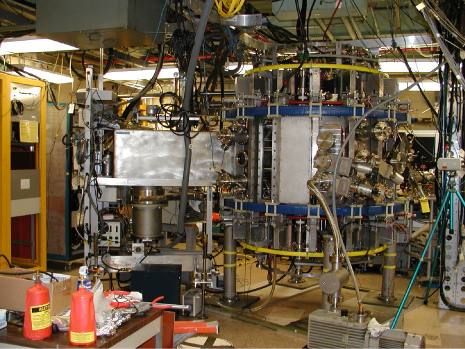Lithium Tokamak Experiment-Beta .jpg

This blog is usually about nuclear fission because there have been nuclear reactors and nuclear weapons for decades. I sometimes write about nuclear fusion because it would be a better way to generate electricity if it can be perfected. Here is another piece of the puzzle.
Tokamak fusion reactors are donut-shaped vessels in which powerful magnetic fields confine and heat plasmas in the center of the vessel. One of the problems with tokamak fusion reactors is the fact the if the plasma escapes confinement of the magnetic fields, it can impinge on the sides of the tokamak. This can result in quenching of the fusion reaction at the very least and actual physical damage to the walls of the tokamak at the worst.
Lithium is a very light metal that has many industrial and consumer uses. One of the main uses is in highly efficient batteries. Lithium can be used inside a tokamak to protect the walls from escaping plasma. It can also be used to produce tritium. Tritium can be combined with deuterium to produce the fusion reaction.
At the U.S. Department of Energy's (DOE) Princeton Plasma Physics Laboratory (PPPL), researchers have spent three years upgrading the Lithium Tokamak Experiment to the Lithium Tokamak Experiment-Beta (LTX-β). This is a device that will be able to test the ability of lithium to protect the walls of a tokamak.
During the upgrade, the researchers installed a neutral beam injector which they borrowed from TAE Technologies. They also increased the power of the magnetic field that confines the plasma. And they installed new lithium systems. These changes were made to bring the device closer to the design of an actual fusion reactor.
The device has a coating of lithium that covers the interior walls of the small tokamak. The first significant accomplishment of the device before the upgrade was to maintain a constant temperature in the plasma from the center of the confinement to the outer edge.
Completing the upgrade allowed the device to produce five hundred kilowatts of neutral beam power. It also increased the strength of the magnetic confinement by two thirds. The lithium coating on the interior walls absorbs stray particles of plasma and prevents them from rebounding into and cooling the confined plasma. Subsequent to the original upgrade, the researchers increased the neutral beam power to over six hundred watts. They also increased the heating power of the device by a factor of ten.
The next test that will be carried out will determine in the device can maintain good confinement and constant temperatures in much hotter plasmas with more powerful magnetic fields. The beam upgrade will prevent the density of the plasma from dropping and will also demonstrate whether or not hotter and more energetic plasmas can be properly controlled to sustain the fusion reaction.
During the upgrade, the research team had to install a much stronger power supply and a new lithium evaporator. Dick Majeski is the principal investigator of the experiment. He said, "Everyone worked very hard. We got a lot of help from the laboratory's NSTX-U [National Spherical Torus Experiment-Upgrade] engineering team.
The collaboration which carried out the upgrade consisted of scientists from eight major research centers across the U.S. including Oak Ridge and Lawrence Livermore National Laboratories; Princeton University; University of California, Los Angeles; University of Wisconsin-Madison; University of Washington; and University of Tennessee, Knoxville.